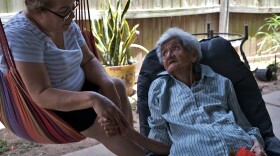Health officials and aid workers from the U.S. and Mexico want to find out how many asylum seekers at the border are living with HIV.
A delegation made up of doctors and aid workers recently toured a migrant resource center and shelter in Matamoros, Mexico to better understand how they can care for them.
The delegation’s first stop was a resource center for asylum seekers run by Gaby Zavala. The center offers legal services and some medical screenings. Zavala told the health officials that she could open their space to help provide rapid HIV testing.
There’s a need for testing here, Zavala said, because many asylum seekers are afraid to leave the area.
The resource center is right next to a tent encampment of more than 1,500 migrants who have been waiting months for their day in immigration court under the Trump administration’s Remain in Mexico policy.
“The fact that a tent city has emerged, you’re talking about a city within a city. The only difference is that all those things go unchecked, so things like sexual assault, things like rapes, and things like commercial sex work, they go unchecked,” Zavala said. “Being able to provide those services also gets people into treatment.”
Zavala said it has taken months for health issues like HIV testing to become a priority.

“We were first worried about, ‘What are they going to eat? Where are they going to stay?’” said Zavala. “Now we get to start thinking about things like, ‘Well what about health?’ Like counseling, STDs, HIV, things that often take the back burner because you’re so worried about survival.”
Before health officials left, they committed to following-up in a few days to see how many rapid HIV testing kits they can provide.
The next stop for the delegation was Casa Bugambilia, a shelter where dozens of migrants are staying.
Inside, sounds of children playing filled the halls.
The health officials gathered around a table to discuss how they can work together to provide information about resources for people who have HIV, or who may have the virus.
Pedro Coronado is Vice President of access and continuity of care at Valley AIDS Council. He put together the delegation and tour.
He said about a year ago he received an email from someone saying there was a migrant Venezuelan father and son who were at Casa Bugambilia and were HIV positive.
From there, Coronoado connected the family to health services, so they could get treatment.
Maria Esther Garza is also at the table. She works at Casa Bugambilia and said she doesn’t recall a father and son at their shelter having HIV, but Coronado says the Venezulan family probably didn’t say anything because they weren’t comfortable talking about it. He said it’s important to work together to provide information to the migrants.
Dr. Carlos Alberto Carrillo Garza was also on the tour today. He’s the director of CAPASITS, a Mexican government organization that helps people with STDs and HIV.
He said he’s happy aid workers from both countries were on the tour because they’ve already built trust with the migrants.
He said it’s much easier for migrants to accept the rapid HIV testing from them, rather than with someone from the Mexican government’s health department. He also said that if someone is diagnosed with HIV, there’s a process asylum seekers can go through to get treatment in Mexico.
The tour was part of a binational conference between U.S. and Mexican health officials to come up with a plan to address HIV in communities on both sides of the border.
“What we’re trying to do is create better linkages of people who are HIV positive that are either being repatriated, or that are moving to the U.S.,” said Coronado. “The idea was, if I’m a person that is HIV positive and I’m being sent back to Mexico, where am I going to be able to access care?”
Coronado said another part of the conference was to discuss how officials can better send medical records from one country to another.
He also said it’s important to continue these conversations because rates of HIV tend to be higher along the border and is increasing with the Latino community.
“When we talk about culture, we don’t really talk about sex with our families,” said Coronado. “Latinos, when we talk about prevention, may not be using condoms and now that we have a pill that can prevent you from becoming HIV positive, but the community not taking the medication are our Latinos.”
Coronado said he’s satisfied with how the binational HIV conference went and now that they’ve met with organizations, the next step is drafting and enacting the plan for asylum seekers so they can begin testing more people and get them treatment.
Reynaldo Leaños Jr. can be reached at Reynaldo@TPR.org and on Twitter at @ReynaldoLeanos
Copyright 2019 Texas Public Radio








